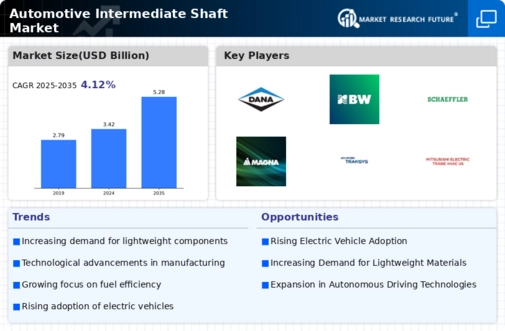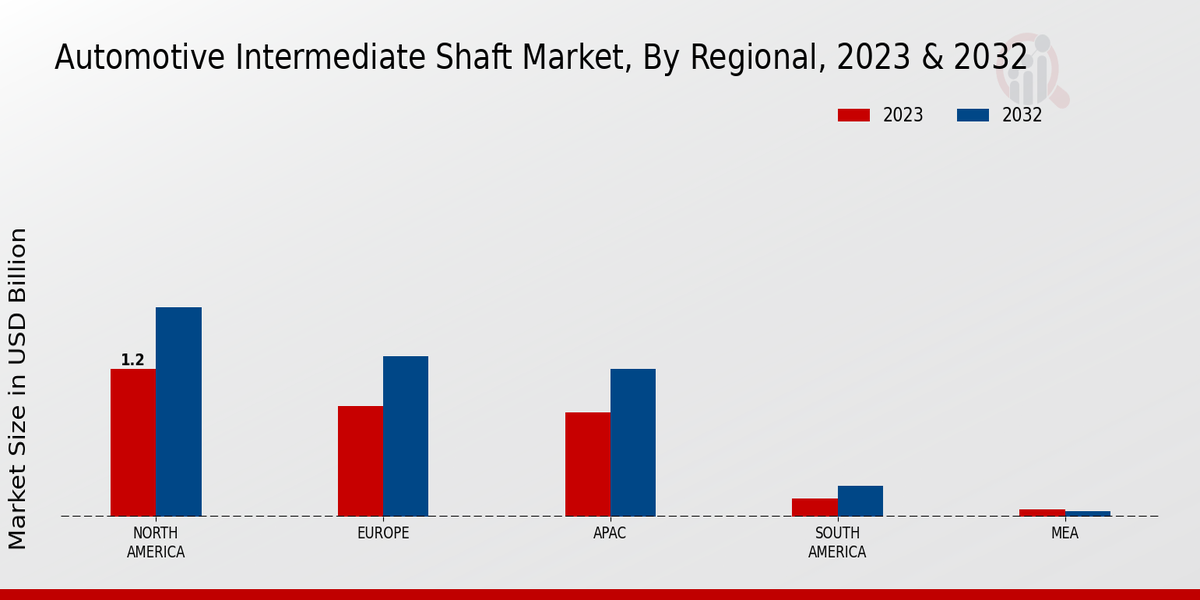Market Growth Projections
The Global Automotive Intermediate Shaft Market Industry is poised for substantial growth, with projections indicating a market size of 3.42 USD Billion in 2024 and an anticipated increase to 5.28 USD Billion by 2035. This growth trajectory suggests a compound annual growth rate (CAGR) of 4.03% from 2025 to 2035, reflecting the industry's resilience and adaptability in response to changing consumer preferences and technological advancements. The increasing focus on fuel efficiency, the rise of electric vehicles, and stringent regulatory standards are likely to shape the market landscape in the coming years, presenting opportunities for manufacturers and stakeholders.
Rising Demand for Fuel Efficiency
The Global Automotive Intermediate Shaft Market Industry is experiencing a notable surge in demand driven by the increasing emphasis on fuel efficiency. As automotive manufacturers strive to meet stringent emissions regulations, the intermediate shaft plays a crucial role in optimizing power transfer and reducing energy losses. This trend is particularly evident in hybrid and electric vehicles, where efficient drivetrain components are essential. The market is projected to reach 3.42 USD Billion in 2024, reflecting the industry's commitment to innovation and sustainability. The growing consumer preference for fuel-efficient vehicles further propels this demand, indicating a shift towards greener automotive solutions.
Growth of Electric and Hybrid Vehicles
The rise of electric and hybrid vehicles is a pivotal driver for the Global Automotive Intermediate Shaft Market Industry. As consumers increasingly opt for eco-friendly transportation solutions, the demand for components that support these technologies is escalating. Intermediate shafts are integral to the drivetrain systems of these vehicles, facilitating efficient power delivery. The market is projected to expand to 5.28 USD Billion by 2035, underscoring the growing importance of this sector. Manufacturers are adapting their designs to cater to the unique requirements of electric drivetrains, which may further enhance the market's growth potential in the coming years.
Increasing Vehicle Production and Sales
The Global Automotive Intermediate Shaft Market Industry is benefitting from the rising vehicle production and sales across various regions. As economies recover and consumer confidence grows, automotive manufacturers are ramping up production to meet the increasing demand for personal and commercial vehicles. This surge in production directly correlates with the need for intermediate shafts, which are essential components in vehicle drivetrains. The anticipated growth in vehicle sales is likely to bolster the market, as more vehicles on the road translate to a higher demand for replacement parts and aftermarket services, further driving the industry's expansion.
Regulatory Compliance and Safety Standards
Regulatory compliance and safety standards are becoming increasingly stringent, influencing the Global Automotive Intermediate Shaft Market Industry. Governments worldwide are implementing regulations aimed at enhancing vehicle safety and reducing environmental impact. Intermediate shafts must meet these evolving standards, prompting manufacturers to invest in research and development to ensure compliance. This focus on safety and environmental responsibility is likely to drive innovation within the industry, as companies strive to produce components that not only meet regulatory requirements but also enhance overall vehicle performance. The ongoing evolution of regulations may create new opportunities for growth within the market.
Technological Advancements in Automotive Design
Technological advancements are significantly influencing the Global Automotive Intermediate Shaft Market Industry. Innovations in materials and manufacturing processes are enhancing the performance and durability of intermediate shafts. For instance, the adoption of lightweight materials such as carbon fiber and advanced alloys is becoming prevalent, contributing to overall vehicle weight reduction. This trend aligns with the industry's focus on improving fuel efficiency and performance. As a result, the market is expected to grow at a CAGR of 4.03% from 2025 to 2035, indicating a robust trajectory fueled by continuous technological evolution and the need for high-performance automotive components.





















